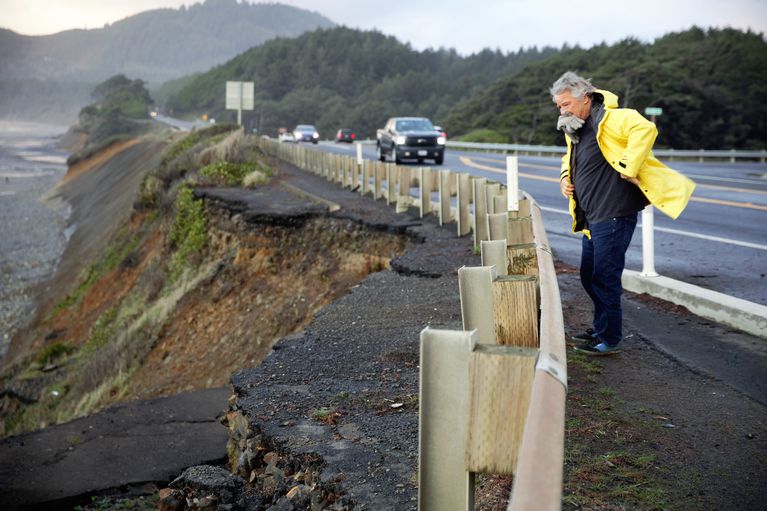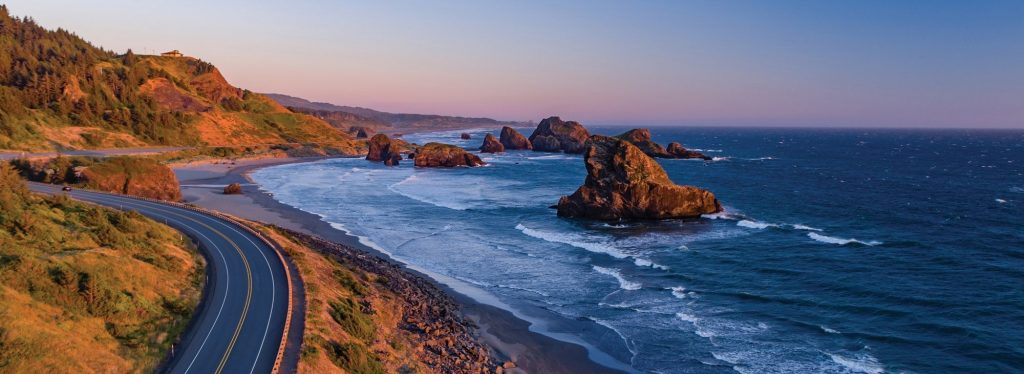 Highway 101, which stretches along the Oregon Coast, is in desperate need of a makeover. Many areas of the highway, particularly Moolack Beach near Newport, are in rough shape due to erosion from the beach’s incessant waves and other elements of Mother Nature.
Highway 101, which stretches along the Oregon Coast, is in desperate need of a makeover. Many areas of the highway, particularly Moolack Beach near Newport, are in rough shape due to erosion from the beach’s incessant waves and other elements of Mother Nature.
Onno Husing, planning director for Lincoln County, knows the problem all too well. From the highway, he can look down and watch the ocean swallow up pieces of pavement that fall from where he is standing.
“It’d be pretty hard to stand here and look at what we’re looking at, and not be concerned,” he told OPB.
The Essential Highway to the West
For many Oregon coast residents, Highway 101 is essential. The stretch of highway connects communities like Lincoln City and Tillamook, acting as a vital path for commuters between work and home.
According to Husing, the highway is in dire need of reinforcing with “rip–rap” – an engineering term that means reducing erosion by strategically placing large rocks near the base of the highway in order to soften the blow of the waves hitting the pavement.
However, the Oregon Land and Conservation Commission introduced Goal 18 in 1977, which forbids the use of riprap on new developments. An exemption would only take place if there were a rare exception.
The intent behind Goal 18 was to discourage turning the Oregon Coast into California, where rip–rap stretches for hundreds of miles at a time. Additionally, cosmetics play a role, as well as the fact that rip rap takes away from the amount of sand left on the beaches. Despite this, developers have pushed the state to redefine the term “development,” and in 1984 described it as “…houses, commercial and industrial buildings, and vacant subdivision lots which are physically improved through construction of streets and provision of utilities.”
“That definition does not include public infrastructure,” said Meg Reed, coastal specialist with the Oregon Land Conservation and Development Commission. “Roads, sewer lines, campgrounds, lighthouses: it doesn’t include any of that in the definition.”
 Protecting Scenery Over Safety
Protecting Scenery Over Safety
For 45 years, the use of rip-rap has been condemned for the use of Highway 101 despite its close proximity to the coast for the better part of 363 miles. While it is no I-5, Highway 101 has still provided essential travel to Oregonians since 1926. Additionally, the highway is sturdy despite the beating it has taken, and has had few improvements since its creation.
In 2002, the Oregon Department of Transportation recognized 25 concerning locations along the highway, including eroded areas, those with landslide hazards, floods, rising sea levels, and storms. Coastal residents are often inconvenienced with extended highway closures – some even lasting weeks. In fact, when certain areas are closed, drivers may have to drive out to the Willamette Valley in order to arrive at their destination.
The communities spoke out regarding their concerns and were met with revisions for Goal 18 to move towards repairs for the highway. However, as with any hot topic, these revisions soon became a point of conflict for leaders.
“It got pretty far until it came to our commission for its final hearings, and then there was a big public outcry from many different sides,” said Reed.
Unfortunately, this led to the ultimate decision of leaving Goal 18 be – and leaving Highway 101 to crumble.
Now, another 25 years later, the “areas of concern” deemed by ODOT are now major hazards. Another attempt at a Goal 18 revision is in the works, but will look a lot different this time around.
“We’re going to put in a specific exemption for public roads along the oceanfront that were developed as of January 1, 1977,” Reed said.
Where ODOT Stands
ODOT is not hard to convince when it comes to Highway 101 revisions.
“ODOT very much welcomes any change to the current Goal 18 exception process,” said Geoff Crook with the state transportation department.
However, convincing certain environmental groups of the needed changes may prove more difficult. Briana Goodwin with the Surfrider Foundation shared the desire to make the roads safe, but expressed concerns of overdevelopment.
“We know that developers are waiting to see what happens with Highway 101,” said Goodwin. “And we do expect that if the law is loosened up at all or any loopholes are opened, that there will be a lot more applications for Goal 18 exceptions.”
Terrifyingly, however, time may be of the essence when it comes to these repairs. Husing explained that if the roads suddenly gave way, emergency laws would override those in place and install riprap within hours.
“ODOT would be here on an emergency basis,” he said. “It’d make your head spin. They’ll come in here and they’ll fix that.”
The consequences in that scenario, however, may be catastrophic. Husing claims that it will not come to that, as authorities think too highly of the highway to let it fall by the wayside.
The Oregon Department of Land Conservation and Development created an advisory board to help formulate new language in Goal 18. The committee includes small business representatives, environmentalists, an ODOT representative, a Tillamook County Public Works representative, and a Coos County commissioner.
Once language is official, a seven-member governor-appointed commission will hold public hearings over the summer, and is estimated to vote on the issue in July.
By Rebekah Harcrow
Do you have a story for The Advocate? Email editor@corvallisadvocate.com


